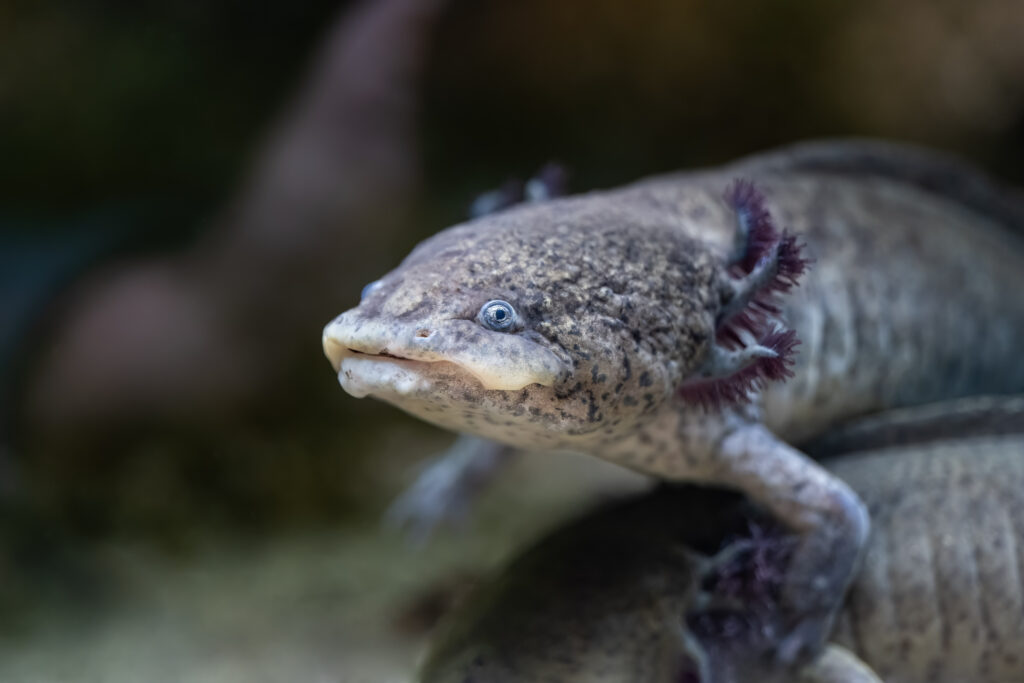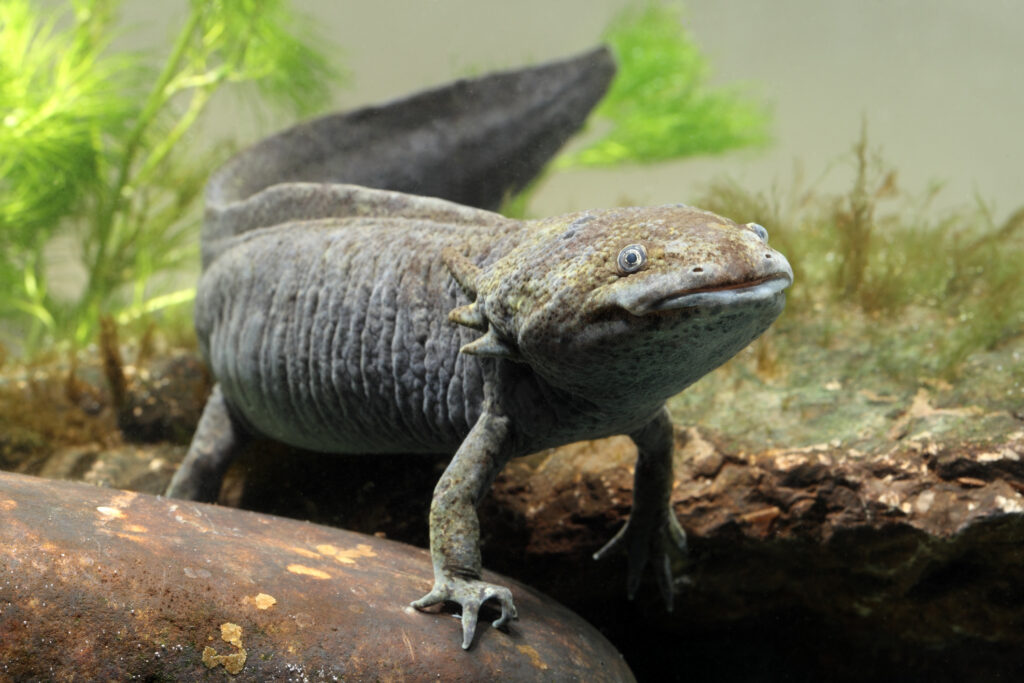We’re here to introduce one of the most fascinating creatures in the natural world: the axolotl. This truly unique creature, a member of the salamander family, is commonly referred to as ‘the walking fish’ – and you’ll soon figure out why.
In this guide, we’ll be filling you in on the remarkable axolotl, from its amazing genetics to where it’s found in the wild. We’ll also be taking a look at why its numbers are in such sharp decline, and what impact its disappearance could have for us all.
What is an axolotl?
Axolotl (Ambystoma mexicanum) is a member of the Ambystomatidae family of salamanders. They have a rare condition called ‘neoteny’, which is the slowing down of development. This means they retain most of their larval features into adulthood, so they have all the features of a tadpole – from feathery gills to a long, quill-like dorsal fin – even when they’re fully mature.
They are commonly mistaken for fish, but there’s so much more to this fascinating creatures, and are sometimes known as Mexican walking fish, on account of their appearance and adopted habitat.

What does an axolotl look like?
Most of your experience with axolotl will probably tell you that they are usually white or pale pink in colour, but in the wild they are typically a darker colouring, including brown- grey with green or gold mottling!
They have wide heads with short limbs, and three pairs of feathery gills. Axolotl also have webbed feet and a dorsal fin that runs the length of their body. They can grow up to 30cm in length on average, but this can range between 15 to 45cm, and will typically weigh between 50-250g.
Where do axolotl live?
Axolotls are exclusively found in two freshwater lates in Mexico – Lake Xochimilco and Lake Chalco. You’ll find these lakes in the southern region of Mexico City. However, these creatures are rarely seen in person.
Axolotls have, for many centuries, been an important part of Mexican culture. According to local mythology, the creature is an embodiment of an Aztec god who disguised himself as a salamander to avoid sacrifice. Sadly, they’re also viewed as a delicacy within Mexico City, with overfishing contributing to their appearance on the critically endangered species list.
What do axolotls eat?
Axolotls are carnivores, surviving on a diet of worms, insects, crustaceans, molluscs and some small species of fish. Even though they have undeveloped teeth, they are able to catch their prey effectively, using a suction method. Sometimes they will even suck up gravel too, to help grind down the food in its stomach.
Until recent decades, they were at the top of the food chain within their distribution habitat, but today invasive species of perch and tilapia pose a threat and have contributed to a decline in their numbers.
Lifespan of an axolotl
An axolotl can live on average for around 10-15 years, although it can depend greatly on any threats to its habitat. In some cases, their ability to regrow limbs can help them to live longer, as they’re able to regenerate.
In the wild, axolotls will breed once a year, usually around February. Females can lay up to 1,000 eggs and they typically hatch after around 2 weeks. They receive no parental care and the larvae swim off on their own from the very beginning!

How do axolotls differ from other salamander species?
It’s hard to believe that axolotls are within the same subset of amphibians as their salamander counterparts. Appearance, anatomy, habitat – there’s much that makes them different from the likes of newts, olms, and fire salamanders, and it’s very easy to see why they’re colloquially known as ‘walking fish’.
Let’s take a look at what makes axolotls so different from any other species of salamander:
- Axolotls are larger than many other salamander species, growing significantly bigger than animals which are also found on land.
- The axolotl is native only to Lake Xochimilco in the Valley of Mexico, as well as the canals and waterways of Mexico City.
- Because they’re neotenic, their habitat reflects this: a high-altitude body of water. This is unique to axolotls, with other salamanders having a much wider distribution.
- Axolotls, unlike most other salamander species, live permanently in water. Some animals have been known to venture onto land upon reaching full maturity, but the majority of their lives are spent beneath the surface, using gills to breathe.
Are axolotls endangered?
The IUCN red list classifies the axolotl as ‘critically endangered’, which means their numbers are becoming smaller and smaller.
A lot of factors have contributed to the sharp decline in axolotl numbers in recent years – and it really has been a steep decrease. According to a study carried out by Mexican biologist Luis Zambrano, there were 6,000 axolotls per square kilometre in the Xochimilco lake complex in 1998; today, there are just 35.
Let’s take a look at some of the likely causes of this huge drop in axolotl numbers:
- Water pollution – the rapid development of Mexico City has seen a huge spike in water pollution within the Xochimilco network, making some areas inhospitable for aquatic life.
- Overfishing – axolotl have become something of a delicacy in Mexico City, leading to a huge increase in demand among local fishermen. Overfishing is now one of the biggest threats to axolotl numbers.
- Habitat loss – the rapid development of Mexico City has seen vast swathes of the Xochimilco lake complex drained and destroyed, including Lake Chalco, one of axolotl’s principal historic habitats.
- Invasive species – historically sitting at the top of the food chain in Xochimilco, a handful of invasive species have since been introduced to axolotl’s habitat. Animals like perch and tilapia have decimated axolotl numbers, significantly contributing to their decline.
Why are declining axolotl populations concerning?
While many marine and freshwater species face tough challenges in the wild, scientists are particularly concerned about the decline in axolotl numbers because of their huge biological value. These unusual salamanders are among the most studied freshwater creatures in the world, and scientists believe that there is still much humans can learn from their genetic makeup.
One of the attributes of axolotls which has fascinated biologists for decades is their ability to regenerate limbs. Should an animal lose a foot, for example, they’re able to regenerate the limb in a relatively short space of time – something which scientists believe could hold great biological value for human medicine and the treatment of certain degenerative diseases.
And while there are still huge numbers of axolotls in captivity, scientists are concerned that inbreeding is impacting their long-term health and genetic characteristics – effectively weakening their value from a biological standpoint. There are also concerns that the number of inbred animals could have a negative long-term impact on conservation efforts, as diseases and deficiencies take hold.
What is clear is that, until significant efforts are made to safeguard axolotl numbers in their natural habitat, the species faces a very real and imminent threat of disappearing. Conservation is therefore key to the future of this unique and remarkable species.
At Blue Reef Aquarium Portsmouth, we’re proud of our work in helping to preserve and showcase the amazing axolotl. If you’d like to meet these amazing animals, why not join us for a memorable family visit – we have a whole host of creatures to discover. For information and tickets, visit the homepage.
